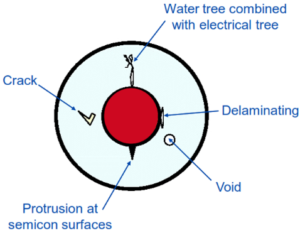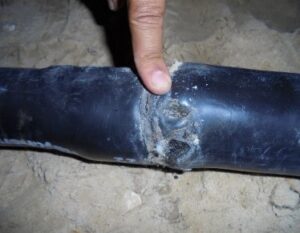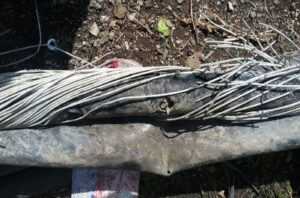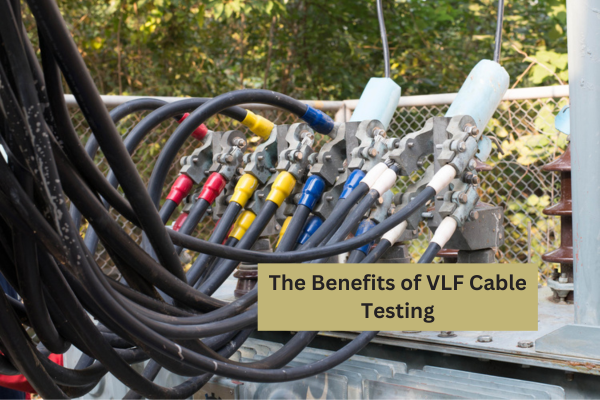Introduction
VLF (very low frequency) cable testing is a technique used to detect incipient defects in medium and high voltage cables. It involves applying a high voltage, low frequency AC signal to the cable and measuring several parameters to quantify its condition. The benefits of VLF cable testing include reduced risk of cable failure, prevention of expensive outages, increased reliability & safety and extending cable life.
Background
For many decades, the standard practice for assessing cable condition was to apply DC high voltage and test whether the cable could withstand that. However, standardization of XLPE cables and a better understanding of XLPE properties led to the discovery that the applying DC voltage is actually harmful to the cable.
This is due to a phenomenon called space charge, which leads to over-voltages in a cable and can lead to failure.

IEEE actually has issued a warning against the use of DC Hipot testing for XLPE cables. In this scenario, it was obvious that AC voltage testing had to be used. However, the very high voltages and the large charging currents required for AC testing made the exercise prohibitively expensive, if test was to be performed at line frequency.
Experiments concluded that using a low frequency power source (VLF – sinusoidal 0.1 Hz) to test the cables would not create space charges. In addition, VLF kits are relatively inexpensive and more effective in detecting water ingress than both DC & power frequency tests.
Theory
The most common causes of cable failure are water trees, physical damage and the presence of voids. Identifying these at an early stage and determining their location will help in taking corrective action. In order to detect these, it is insufficient to simply apply a high voltage and measure the leakage current. More advanced measurements are required, as under:
- VLF Tan Delta Test
- VLF Partial Discharge Test
- VLF Monitored Withstand Test
VLF Tan Delta – Tan delta, also known as dissipation factor, is a measure of the currents that flow through insulation when AC voltage is applied between the cable conductor and the ground. Typically, there will be a small resistive current and a significant capacitive current. The ratio of these two gives us the tan delta value. The higher the tan delta value (and the more that it changes with voltage), worse is the condition of the insulation.

Tan delta, when measured with a VLF test kit, is highly sensitive to water trees and physical damage. In addition, IEEE 400.2 has given very clear guidelines for the use of VLF tan delta and has set limits. IEEE strongly recommends this test for both new and old cables.
VLF Partial Discharge – Partial discharge (PD) is a phenomenon that occurs when there is a localized breakdown of the dielectric, causing electric charges to be transferred. Most often, this happens in voids within the insulation, which are present due to manufacturing defects or poor site installation practices. This localized breakdown on the application of high voltage will lead to electrical treeing within the insulation, and subsequent failure.
By connecting a special sensor (capacitive coupler) to the cable and applying a high voltage VLF signal, such PD activity can be detected at an early stage. IEEE 400.3 is a very good reference guide in this matter. The beauty of the VLF PD test is that is also identifies the location where PD is occurring, so that corrective action can be taken.

Case Studies
Physical damage & water treeing detected by VLF tan delta – Twenty-year-old 35 kV cables were tested. VLF tan delta was very poor, indicating imminent failure. The weak spot identified and excavated. A severely damaged joint was found. Had it failed in service, the daily losses would have been in excess of a crore.

Electric trees detected by VLF partial discharge – A 33 kV cable showed PD activity in the straight portion when tested using VLF. Decision was taken to take the cable back in service. A few days later, the cable failed, leading to a breakdown of the entire plant. This could have been averted had the PD data taken more seriously.

Benefits of VLF cable testing
- Early detection of cable defects
Cable faults can cause power outages, equipment damage, and safety hazards. VLF cable testing can detect incipient defects in cables early, allowing maintenance personnel to repair the cables before they worsen and fail.
- Predictive maintenance & Increased reliability
VLF cable testing can also be used to predict the likelihood of future cable failures. By testing the cable over time, engineers can identify trends in its parameters and predict when it may fail. This allows maintenance personnel to schedule repairs before the cable fails, reducing downtime and maintenance costs.
- Improved safety
Cable failures can pose safety hazards to personnel and equipment. By detecting cable faults early and performing necessary repairs, VLF cable testing can improve safety by reducing the risk of electrical accidents and equipment damage.
- Cost savings
By detecting cable defects early and performing necessary maintenance, VLF testing can prevent expensive outages as well as reduced replacement costs.
In conclusion, VLF cable testing is a valuable diagnostic tool that can help improve the reliability and safety of electrical distribution systems, while giving huge cost savings. Maintenance personnel should consider incorporating VLF testing services into their routine maintenance programs. At Diatech, we provide such professional services using the latest technologies. For more information contact us or request a quote.


Well written! Easy to understand.
Really Very informative/knowledgable blogs which clear the need of cable testing as well as what are test which are to be performed.
Very interesting article for cable diagnostic. Which instrument do you use to pin-point weak points or very high PD location. Do you have case study in which you have find weak point where high PD is occurs and repaired before actual cable fault occurred.